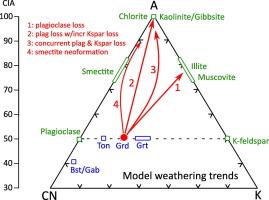化学蚀变指数(CIA)和 ACNK 图的解释
IF 3.6
2区 地球科学
Q1 GEOCHEMISTRY & GEOPHYSICS
引用次数: 0
摘要
化学蚀变指数(CIA)和 ACNK 三元图(即顶点为 Al2O3、CaO + Na2O 和 K2O)是评估土壤和沉积物化学风化模式最广泛使用的工具之一。然而,这些工具的错误使用在最近的文献中非常普遍,因此有必要对 CIA 代用图和 ACNK 图的最佳实践、它们对迁移沉积物化学风化强度的影响以及对深时地层中的元气效应的认识进行 "纠正性 "讨论。正如现代土壤剖面中风化趋势的多样性所显示的那样,假设古溶胶的 "理想风化趋势"(IWT)与 A-CN 轴平行一般是不合理的。使用 IWT 来推断古溶岩中是否存在过量的钾(K),可能会导致错误的钾金属化推断,并对 CIA 值进行不必要的 "修正"。根据风化路径重建原岩要求后者在 ACNK 空间中形成一个定义明确的线性阵列,可以准确地向后投影到长石连接处;基于定义不清的数据阵列的投影是没有意义的。在运移沉积物中,由于水力分选、双组分混合系统和沉积物循环等因素,将 ACNK 数据解释为风化替代物变得更加复杂。在新元古代地层中,元气蚀变通常会扰乱 ACNK 空间的风化路径,并伴随着向富含更多 K(或 Ca-Na)成分的明显偏移;然而,这一过程能否在代表明确风化路径的线性样本阵列上运行,并以协调的方式移动所有样本,从而产生一个具有相同排列程度但斜率完全不同的新阵列,这一点值得怀疑。虽然古近纪古溶胶的钾富集被广泛归因于钾-金属化作用,但还需要考虑与大气氧含量上升有关的超基因风化作用的潜在作用,即通过粘土矿物的早期灰化来促进成土钾的保留。为了获得最大的稳健性,古溶胶和古地貌中的风化作用研究必须将移动碱基信息(即以 CIA 代用和 ACNK 关系为形式的 Ca-Na-K)与 Fe-Mg、SiO2 和抗蚀元素的成分数据以及记录矿物相关系和样品成因历史的岩石学数据结合起来。总之,有必要对 CIA 代用图和 ACNK 图进行更细致的使用和解释。本文章由计算机程序翻译,如有差异,请以英文原文为准。

The chemical index of alteration (CIA) and interpretation of ACNK diagrams
The chemical index of alteration (CIA) and ACNK ternary diagrams (i.e., with apices of Al2O3, CaO + Na2O, and K2O) are among the most widely used tools for evaluation of chemical weathering patterns in soils and sediments. However, incorrect use of these tools has become prevalent in recent literature, necessitating a “corrective” discussion of best practices for the CIA proxy and ACNK diagrams, their implications for the chemical weathering intensity of transported sediments, and the recognition of metasomatic effects in deep-time formations. As shown by the diversity of weathering trends in modern soil profiles, the assumption of an “ideal weathering trend” (IWT) for paleosols that runs parallel to the A-CN axis is generally unjustified. Use of an IWT to infer the presence of excess potassium (K) in a paleosol can lead to incorrect inferences of K-metasomatism and to unwarranted “corrections” of CIA values. Protolith reconstruction from a weathering path requires that the latter form a well-defined linear array in ACNK space that can be accurately projected backward to the feldspar join; projections based on poorly defined data arrays are meaningless. In transported sediments, the interpretation of ACNK data as a weathering proxy is further complicated by factors such as hydraulic sorting, two-component mixing systems, and sediment recycling. In metasedimentary formations, metasomatic alteration commonly disrupts weathering paths in ACNK space accompanied by pronounced shifts toward more K- (or Ca-Na-)rich compositions; however, it is doubtful whether this process can operate on a linear sample array representing a well-defined weathering path and shift all samples in a coordinated manner to produce a new array with an equal degree of alignment but an entirely different slope. Although K-enrichment of Paleoproterozoic paleosols has been widely attributed to K-metasomatism, the potential role of supergene weathering linked to rising atmospheric oxygen levels in promoting pedogenic K retention through early illitization of clay minerals requires consideration. For maximum robustness, studies of weathering in paleosols and paleoformations must combine information for the mobile bases (i.e., Ca-Na-K, in the form of the CIA proxy and ACNK relationships) with compositional data for Fe-Mg, SiO2, and resistate elements as well as petrographic data documenting mineral phase relationships and sample paragenetic histories. In summary, more nuanced use and interpretation of the CIA proxy and ACNK diagrams are necessary.
求助全文
通过发布文献求助,成功后即可免费获取论文全文。
去求助
来源期刊

Chemical Geology
地学-地球化学与地球物理
CiteScore
7.20
自引率
10.30%
发文量
374
审稿时长
3.6 months
期刊介绍:
Chemical Geology is an international journal that publishes original research papers on isotopic and elemental geochemistry, geochronology and cosmochemistry.
The Journal focuses on chemical processes in igneous, metamorphic, and sedimentary petrology, low- and high-temperature aqueous solutions, biogeochemistry, the environment and cosmochemistry.
Papers that are field, experimentally, or computationally based are appropriate if they are of broad international interest. The Journal generally does not publish papers that are primarily of regional or local interest, or which are primarily focused on remediation and applied geochemistry.
The Journal also welcomes innovative papers dealing with significant analytical advances that are of wide interest in the community and extend significantly beyond the scope of what would be included in the methods section of a standard research paper.
 求助内容:
求助内容: 应助结果提醒方式:
应助结果提醒方式:


